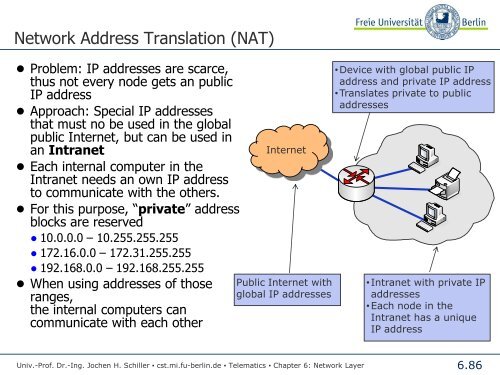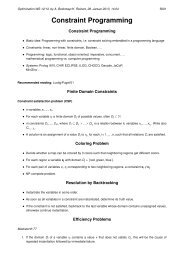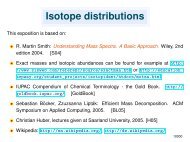Telematics Chapter 6: Network Layer - Freie Universität Berlin
Telematics Chapter 6: Network Layer - Freie Universität Berlin
Telematics Chapter 6: Network Layer - Freie Universität Berlin
You also want an ePaper? Increase the reach of your titles
YUMPU automatically turns print PDFs into web optimized ePapers that Google loves.
<strong>Network</strong> Address Translation (NAT)<br />
● Problem: IP addresses are scarce,<br />
thus not every node gets an public<br />
IP address<br />
● Approach: Special IP addresses<br />
that must no be used in the global<br />
public Internet, but can be used in<br />
an Intranet<br />
● Each internal computer in the<br />
Intranet needs an own IP address<br />
to communicate with the others.<br />
● For this purpose, “private” address<br />
blocks are reserved<br />
● 10.0.0.0 – 10.255.255.255<br />
● 172.16.0.0 – 172.31.255.255<br />
● 192.168.0.0 – 192.168.255.255<br />
● When using addresses of those<br />
ranges,<br />
the internal computers can<br />
communicate with each other<br />
Internet<br />
Public Internet with<br />
global IP addresses<br />
Univ.-Prof. Dr.-Ing. Jochen H. Schiller ▪ cst.mi.fu-berlin.de ▪ <strong>Telematics</strong> ▪ <strong>Chapter</strong> 6: <strong>Network</strong> <strong>Layer</strong><br />
• Device with global public IP<br />
address and private IP address<br />
• Translates private to public<br />
addresses<br />
• Intranet with private IP<br />
addresses<br />
• Each node in the<br />
Intranet has a unique<br />
IP address<br />
6.86
















